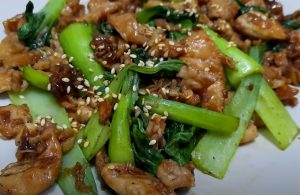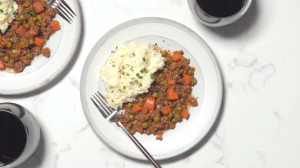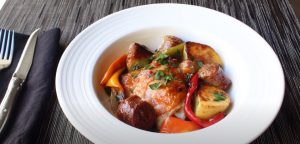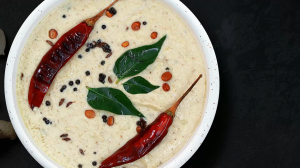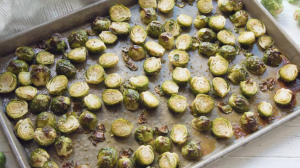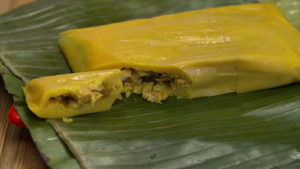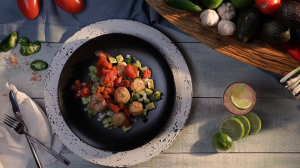This delicious roasted salmon with spaghetti-squash salad recipe is a perfect blend of savory and tangy. Featuring the rich, velvety taste of fresh salmon, the recipe is brightened up by the citrusy undertones of orange and lime. The spaghetti squash adds a unique texture and absorbs the dressing wonderfully, making every bite a delightful gastronomic experience.
The main uncommon ingredient in this recipe is spaghetti squash, a winter squash that, when cooked, separates into spaghetti-like strands. This unique squash is high in nutrients and is a wonderful low-carb substitute for pasta. If you're unfamiliar with spaghetti squash, you can usually find it in the produce section of your local supermarket alongside other varieties of squash.
Roasted Salmon and Spaghetti-Squash Salad Ingredients
Spaghetti squash: A low-carb pasta substitute, this squash separates into spaghetti-like strands when cooked.
Vegetable oil: It's used to roast the salmon and create the dressing.
Fresh lime juice: Brings a tangy citrus flavor to the salad dressing.
Fresh orange juice: Adds a hint of natural sweetness to the salad dressing.
Garlic cloves: Provides a spicy, aromatic flavor to the dressing.
Red chile: Adds a spicy kick to the dressing.
Orange zest: Gives a strong citrus flavor to the dressing.
Lime zest: Provides a tangy taste to the dressing.
Salmon fillet: The star of this dish, roasted to perfection.
Kirby cucumbers: These small, firm cucumbers add a refreshing crunch to the salad.
Mint: Brings a fresh, herbal note to the salad.
One reader, Hedwiga Curran says:





The roasted salmon with spaghetti-squash salad recipe is a game-changer! The flavors are a delightful blend of citrus and spice, and the salmon is perfectly tender. The spaghetti squash salad is a refreshing and unique twist. This recipe is a definite winner for a healthy and delicious meal.
Techniques Required for Making Roasted Salmon with Spaghetti-Squash Salad
How to roast the salmon: Brush the salmon slices with oil, season with salt and pepper, and roast in a preheated 500°F oven for about 3 minutes, or until barely cooked through.
How to cook the spaghetti squash: In a large pot of boiling salted water, cook the spaghetti squash for about 12 minutes until al dente. Then, carefully transfer the squash halves to a large bowl and let them cool. Using a fork, scrape up and separate the strands, and pat them dry with paper towels.
How to make the dressing: Combine the vegetable oil with the lime and orange juices, garlic, chile, orange zest, lime zest, and season with salt and pepper.
How to assemble the salad: In a medium bowl, toss the cucumbers, mint, and dressing with the spaghetti squash strands. Mound the salad on plates, top with the roasted salmon, and serve.
How To Make Roasted Salmon with Spaghetti-Squash Salad
Perfectly roasted salmon is served alongside an equally bright salad with cucumbers, spaghetti squash, orange and lime for a delicious & vibrant meal.
Serves:
Ingredients
- 3½lbsspaghetti squash
- 2tbspvegetable oil
- 2tbspfresh lime juice
- 2tbspfresh orange juice
- 2smallgarlic cloves
- 1smallred chile
- ½tsporange zest,finely grated
- ¼tsplime zest,finely grated
- salt and freshly ground pepper
- 1½lbssalmon fillet,(skinless center cut)
- 2largekirby cucumbers
- 2tbspmint,shredded
Instructions
-
Preheat the oven to 500 degrees F
-
In a large pot of boiling salted water, cook the squash for about 12 minutes until al dente.
-
Meanwhile, combine the 2 tablespoons of oil with the lime and orange juices, garlic, chile and orange and lime zests.
-
Season with salt and pepper.
-
Carefully transfer the squash halves to a large bowl and let cool.
-
Using a fork and starting at 1 end of each piece of squash, scrape up and separate the strands.
-
Pat dry with paper towels.
-
Spread the salmon slices on a rimmed baking sheet.
-
Brush lightly with oil and season with salt and pepper.
-
Roast the salmon for about 3 minutes, or until barely cooked through.
-
In a medium bowl, toss the cucumbers, mint and dressing with the squash strands.
-
Mound the salad on plates, top with the salmon and serve.
Nutrition
- Calories: 578.98kcal
- Fat: 32.41g
- Saturated Fat: 6.21g
- Trans Fat: 0.05g
- Monounsaturated Fat: 11.65g
- Polyunsaturated Fat: 8.87g
- Carbohydrates: 37.22g
- Fiber: 7.71g
- Sugar: 14.73g
- Protein: 38.90g
- Cholesterol: 93.55mg
- Sodium: 1755.71mg
- Calcium: 153.05mg
- Potassium: 1367.64mg
- Iron: 2.93mg
- Vitamin A: 42.77µg
- Vitamin C: 38.72mg
Helpful Technique for Perfecting This Salmon Recipe
When roasting salmon, it's important to not overcook it as it can become dry and lose its flavor. A good rule of thumb is to cook it for about 4 to 6 minutes per half-inch of thickness. Also, when preparing spaghetti squash, using a fork to scrape up and separate the strands will give you the best texture, resembling that of actual spaghetti. Remember to let the squash cool before you start scraping to avoid burning your fingers.
Time-Saving Tips for Preparing This Recipe
Prep ahead: To save time, consider prepping the spaghetti squash and dressing in advance. Store them separately in airtight containers in the refrigerator until ready to use.
Use pre-cut salmon: Opt for pre-cut salmon fillets to eliminate the need for slicing and save time during the preparation process.
Multitask: While the squash is cooking, use that time to prepare the dressing and gather the remaining ingredients to streamline the cooking process.
Invest in a good vegetable peeler: A high-quality vegetable peeler can make quick work of prepping the spaghetti squash, saving you time and effort.
Batch cooking: Consider roasting extra salmon fillets and preparing additional squash salad to have ready-made meals for the next day, saving time on future cooking.
Substitute Ingredients For Roasted Salmon with Spaghetti-Squash Salad Recipe
spaghetti squash - Substitute with zucchini noodles: Zucchini noodles can be used as a low-carb alternative to spaghetti squash and provide a similar texture and mild flavor.
vegetable oil - Substitute with olive oil: Olive oil adds a rich flavor and healthy fats to the dish, enhancing the overall taste and nutritional value.
fresh lime juice - Substitute with lemon juice: Lemon juice can be used as a substitute for lime juice, providing a similar level of acidity and citrus flavor to the dish.
fresh orange juice - Substitute with tangerine juice: Tangerine juice can be used as a substitute for orange juice, offering a slightly sweeter and tangier flavor profile.
garlic cloves - Substitute with shallots: Shallots can provide a milder, sweeter flavor compared to garlic, adding a subtle depth to the dish.
red chile - Substitute with jalapeño: Jalapeño peppers can be used as a substitute for red chiles, offering a similar level of heat and a slightly different flavor profile.
orange zest - Substitute with mandarin zest: Mandarin zest can be used as a substitute for orange zest, providing a similar citrusy aroma and flavor to the dish.
lime zest - Substitute with lemon zest: Lemon zest can be used as a substitute for lime zest, offering a similar citrusy aroma and flavor to the dish.
salmon fillet - Substitute with arctic char fillet: Arctic char has a similar taste and texture to salmon, making it a suitable substitute for this recipe.
kirby cucumbers - Substitute with English cucumbers: English cucumbers can be used as a substitute for kirby cucumbers, providing a similar crisp texture and mild flavor.
mint - Substitute with cilantro: Cilantro can be used as a substitute for mint, adding a fresh and herbaceous flavor to the dish.
Best Way to Present Roasted Salmon with Spaghetti-Squash Salad
Elevate the spaghetti squash strands: Gently arrange the strands on the plate, creating a visually appealing base for the dish.
Artfully place the roasted salmon: Carefully position the perfectly cooked salmon fillet on top of the spaghetti squash, ensuring it is the focal point of the dish.
Garnish with cucumber and mint: Add a pop of color and freshness by strategically placing the cucumber slices and mint leaves around the plate.
Drizzle with citrus dressing: Use a steady hand to drizzle the citrus dressing over the salmon and squash, adding a burst of flavor and a touch of elegance to the presentation.
Incorporate microgreens for a finishing touch: Sprinkle a few delicate microgreens over the dish to add a final flourish and a hint of sophistication.
Essential Tools for Making This Salmon Recipe
- Oven: You will need an oven to roast the salmon at a high temperature.
- Large pot: A large pot is required to boil the spaghetti squash.
- Large bowl: A large bowl is needed to mix the dressing and toss the cooked spaghetti squash.
- Rimmed baking sheet: This is used to roast the salmon in the oven.
- Paper towels: These are used to pat dry the cooked spaghetti squash.
- Fork: A fork is used to scrape and separate the strands of the cooked spaghetti squash.
- Medium bowl: A medium-sized bowl is used to toss the cucumbers, mint, and dressing with the spaghetti squash strands.
Storing and Freezing Roasted Salmon with Spaghetti-Squash Salad
Here are the storing and freezing guidelines for roasted salmon with spaghetti squash salad:
- Refrigerate any leftover salmon and spaghetti squash salad separately in airtight containers for up to 3 days. The salmon is best enjoyed fresh, as reheating it can cause it to dry out and lose its delicate texture.
- If you need to store the salad longer, you can freeze the spaghetti squash strands on their own for up to 2 months. Allow the cooked squash to cool completely, then place the strands in a freezer-safe bag or container, removing as much air as possible to prevent freezer burn. Thaw the frozen spaghetti squash in the refrigerator overnight before using it in the salad.
- The dressing can be prepared ahead of time and stored in a jar or airtight container in the refrigerator for up to 5 days. Give it a good shake or stir before tossing it with the spaghetti squash and cucumbers.
- While it's best to enjoy the salad fresh, you can store the assembled salad (without the salmon) in the refrigerator for up to 2 days. Keep in mind that the cucumbers may release some liquid and the spaghetti squash strands may soften slightly. Give the salad a good toss before serving and adjust the seasoning if needed.
- It's not recommended to freeze the assembled salad, as the cucumbers and mint will lose their texture and flavor when thawed. If you want to prepare the salad in advance, store the components separately and assemble them just before serving for the best results.
How To Reheat Leftover Roasted Salmon and Spaghetti Squash
- Preheat your oven to 350°F (175°C). Place the leftover salmon on a baking sheet lined with parchment paper or aluminum foil. Brush the salmon with a little olive oil or melted butter to prevent it from drying out. Bake for 8-12 minutes, or until the salmon is heated through and reaches an internal temperature of 145°F (63°C).
- For the spaghetti squash salad, microwave the leftovers in a microwave-safe dish for 1-2 minutes, stirring halfway through. Be careful not to overheat the salad, as it may become mushy. If the salad seems dry, add a splash of olive oil or lemon juice to refresh the flavors.
- Alternatively, you can reheat the spaghetti squash salad in a skillet over medium heat. Add a little olive oil or butter to the pan and sauté the salad for 3-5 minutes, or until heated through. Stir gently to avoid breaking up the delicate spaghetti squash strands.
- If you prefer a cold salad, simply remove the spaghetti squash salad from the refrigerator about 30 minutes before serving to allow it to come to room temperature. This will help the flavors to develop and make the salad more enjoyable to eat.
- To reheat the salmon and spaghetti squash salad together, place the salmon on top of the salad in an oven-safe dish. Cover the dish with foil and bake in a preheated 350°F (175°C) oven for 12-15 minutes, or until the salmon and salad are heated through.
- For a quick and easy reheating option, you can also use an air fryer. Preheat the air fryer to 350°F (175°C) and place the leftover salmon in the basket. Cook for 3-5 minutes, or until the salmon is heated through and crispy on the outside. Reheat the spaghetti squash salad separately in the microwave or skillet, as mentioned above.
Interesting Fact About Roasted Salmon with Spaghetti-Squash Salad
Spaghetti squash is a great source of vitamins and minerals, including vitamin C, vitamin A, and potassium. It's also low in calories and high in fiber, making it a healthy and nutritious choice for a salad base.
Is Making Roasted Salmon with Spaghetti-Squash Salad Cost-Effective?
This roasted salmon with spaghetti-squash salad recipe is moderately cost-effective for a household. The use of salmon and spaghetti squash may be pricier, but the dish's overall nutritional value and flavor make it a worthwhile investment. The approximate cost for a household of 4 people is around $40. The versatility of the ingredients and the balanced combination of flavors contribute to its appeal. I rate this recipe an 8 for its taste, health benefits, and overall value.
Is This Salmon and Squash Recipe Healthy?
The roasted salmon with spaghetti-squash salad recipe is a relatively healthy dish, offering several nutritional benefits:
- Salmon is an excellent source of omega-3 fatty acids, which are essential for heart and brain health
- Spaghetti squash is a low-calorie, nutrient-dense alternative to traditional pasta, providing fiber, vitamins, and minerals
- The recipe includes fresh vegetables like cucumbers and herbs like mint, adding more nutrients and flavor
- The dressing is made with fresh citrus juices and zest, providing vitamin C and antioxidants
However, there are a few aspects that could be improved to make the dish even healthier:
- The recipe calls for vegetable oil, which is often highly processed and may contain unhealthy fats. Consider replacing it with healthier options like olive oil or avocado oil
- While the recipe includes some vegetables, increasing the variety and quantity of vegetables could further enhance the nutritional value of the dish
- The sodium content may be high depending on the amount of salt used in cooking the squash and seasoning the salmon
To make this recipe even healthier, you could:
- Use olive oil or avocado oil instead of vegetable oil
- Add more colorful vegetables to the salad, such as bell peppers, cherry tomatoes, or carrots, to increase the fiber, vitamin, and antioxidant content
- Reduce the amount of salt used in cooking the squash and seasoning the salmon, and instead rely on herbs, spices, and citrus zest for flavor
- Include a source of healthy carbohydrates, like quinoa or brown rice, to make the meal more balanced and satisfying
- Top the salad with a sprinkle of nuts or seeds, such as almonds or pumpkin seeds, for added healthy fats, protein, and crunch
Editor's Opinion on This Salmon and Squash Dish
The combination of roasted salmon and spaghetti squash salad is a delightful and refreshing dish. The use of citrus juices, garlic, and chile in the dressing adds a zesty and vibrant flavor to the dish. The contrast of the tender spaghetti squash with the perfectly cooked salmon creates a satisfying texture. The addition of cucumbers and mint brings a refreshing element to the salad, making it a well-balanced and flavorful meal. Overall, this recipe offers a harmonious blend of flavors and textures that is sure to impress anyone looking for a light and healthy dish.
Enhance Your Roasted Salmon with Spaghetti-Squash Salad Recipe with These Unique Side Dishes:
Similar Recipes to Try Instead of Roasted Salmon with Spaghetti-Squash Salad
Appetizers and Desserts That Complement Roasted Salmon with Spaghetti-Squash Salad
Why trust this Roasted Salmon with Spaghetti-Squash Salad Recipe:
This recipe guarantees a delightful dining experience with its fresh and vibrant flavors. The use of spaghetti squash as a base provides a healthy and nutritious alternative to traditional pasta. The combination of lime juice and orange juice in the dressing adds a zesty and citrusy punch, enhancing the overall taste. The inclusion of salmon fillet ensures a rich source of omega-3 fatty acids, promoting a heart-healthy meal. Additionally, the incorporation of mint offers a refreshing and aromatic element to the dish. Trust in the quality and balance of ingredients to elevate your culinary journey.
Was this page helpful?
Have your own special recipe to share? Submit Your Recipe Today!





